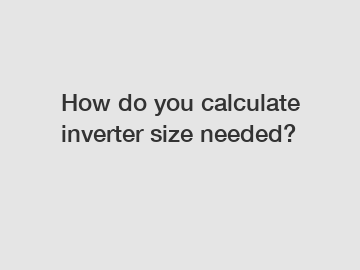How do you calculate inverter size needed?
Choosing the right size inverter for your needs is essential to ensure that you have reliable power when you need it most. Inverters are a crucial component of any off-grid or backup power system, and selecting the right size is crucial for optimal performance. In this blog post, we will explore how to calculate the inverter size needed for your specific requirements.
First and foremost, it is important to understand what an inverter does. An inverter is a device that converts direct current (DC) power from a battery or solar panel into alternating current (AC) power that can be used to power your household appliances or electronics. The size of the inverter refers to its power output capacity, typically measured in watts. The right size inverter will depend on the power requirements of the devices you plan to power.
To calculate the inverter size needed, you will need to determine the total wattage of all the appliances and devices you plan to power simultaneously. This includes items such as lights, refrigerators, televisions, computers, and any other electronics you use regularly. You can usually find the wattage of each device listed on the appliance itself or in the owner's manual. Once you have compiled a list of all the devices and their respective wattages, add up the total wattage to get an idea of the minimum power output your inverter will need to provide.

Keep in mind that some devices may have a startup surge or peak wattage that is higher than their rated wattage. This surge occurs when a device first turns on and can be two to three times higher than the rated wattage. It is important to account for these surges when calculating the inverter size needed to prevent overloading the inverter and causing damage to your devices.
In addition to the total wattage of your devices, you will also need to consider the voltage of your battery bank or solar panel system. Most inverters are designed to work with either 12V, 24V, or 48V battery banks, so it is important to choose an inverter that is compatible with your system voltage. Using an inverter with the wrong input voltage can result in poor performance and reduced efficiency.
Another factor to consider when calculating the inverter size needed is the inverter's efficiency rating. Inverter efficiency is a measure of how much DC power is converted to AC power without being wasted as heat. A higher efficiency rating means that more of the power from your battery or solar panels is being used to power your devices, resulting in improved performance and longer battery life. When choosing an inverter, look for one with a high efficiency rating to maximize the output of your system.
Once you have calculated the total wattage of your devices, factored in any startup surges, and determined the voltage of your battery bank, you can choose an inverter size that meets your specific needs. It is always a good idea to err on the side of caution and choose an inverter with a slightly higher power output than you think you will need to accommodate any future additions to your system.
In conclusion, calculating the inverter size needed for your off-grid or backup power system is a crucial step in ensuring reliable and efficient power supply. By taking into account the total wattage of your devices, accounting for any startup surges, considering the voltage of your battery bank, and choosing an inverter with a high efficiency rating, you can select the right size inverter for your specific requirements. Remember to consult with a professional if you are unsure about the appropriate inverter size for your system to avoid any issues down the line.
If you want to learn more, please visit our website odm manufacturer of power inverters, oem solar inverters manufacturer, 3 phase inverter connection.


